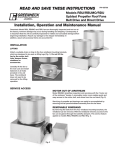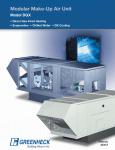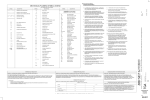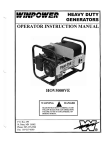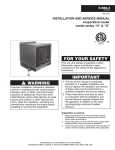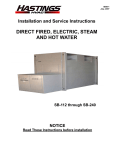Download Greenheck Fan Hooded Propeller Roof Fans User's Manual
Transcript
Part # 455305 READ AND SAVE THESE INSTRUCTIONS Hooded Propeller Roof Fans Belt Drive and Direct Drive GREENHECK ® P.O. BOX 410 SCHOFIELD, WISCONSIN 54476-0410 PH. 715-359-6171 Installation, Operating and Maintenance Manual Upon receiving the unit, check for any damage and report it immediately to the shipper. Also assure all accessory items are accounted for. To minimize installation time, most fans are shipped completely assembled. Due to shipping size limitations, hoods for larger fans will be shipped in sections. For these fans the hood and fan components can be transported to the roof location separately. Hood assembly should begin after the fan is attached to the roof curb. Hood assembly instructions are included with the hood components. Care must be taken not to bend or distort the fan panel or drive components during installation. All dimensions given in inches Exhaust / Supply (Direct Drive Sizes 18-54 - Belt Drive Sizes 20-72) W C B TB D TD Tall Base Option 2 1/2" A sq. Fan Size A Base Sq. C 18 20 24 30 36 42 48 54 60 72 281/4 30 1/4 341/4 401/4 461/4 521/4 581/4 641/4 701/4 82 1/2 13 16 18 20 22 24 24 261/2 261/2 29 Filtered Supply Standard Base B 23 27 29 34 391/2 421/2 431/2 49 50 53 D 10 11 11 14 171/2 181/2 191/2 221/2 231/2 24 Tall Base TB 401/4 441/4 461/4 511/4 563/4 593/4 603/4 661/4 671/4 701/4 WxL TD 271/4 48 x 51 281/4 54 x 51 281/4 66 x 63 311/4 75 x 75 343/4 88 x 87 353/4 86 x 99 363/4 93 x 111 393/4 112 x 111 403/4 124 x 123 411/4 136 x 135 Damper Roof Size Opg. Sq. Sq. 18 20 24 30 36 42 48 54 60 72 20 1/2 22 1/2 26 1/2 32 1/2 38 1/2 44 1/2 50 1/2 56 1/2 62 1/2 74 1/2 (Belt Drive Sizes Only 20 - 72) L Tall Base Option A sq. Fan Size A Base Sq. C 20 24 30 36 42 48 54 60 72 30 1/4 341/4 401/4 461/4 521/4 581/4 641/4 701/4 82 1/2 16 18 20 22 24 24 26 1/2 26 1/2 29 Standard Base B 27 29 34 391/2 421/2 431/2 49 50 53 D 11 11 14 171/2 181/2 191/2 221/2 231/2 24 Tall Base TB 441/4 461/4 511/4 563/4 593/4 603/4 661/4 671/4 701/4 TD 281/4 281/4 311/4 343/4 353/4 363/4 393/4 403/4 411/4 WxL 54 x 51 66 x 63 78 x 87 94 x 87 93 x 99 112 x 111 124 x 123 136 x 135 136 x 147 Damper Roof Size Opg. Sq. Sq. 20 24 30 36 42 48 54 60 72 Access to the motor compartment On fan sizes 18 to 48: - Remove two fasteners shown in fig. 1. Carefully swing the hood 180 degrees and let it rest on the roof. If desired, the entire hood may be removed by removing the two additional fasteners on the opposite side of the fan. Use caution when handling the hood in strong winds. On fan sizes 36 to 60 access to the motor compartment can also be made by either: - Removing birdscreen or filters and standing under the hood of large fans. - Removing one interlocking hood end section of smaller units Fig. 1 Fasteners 22 1/2 26 1/2 32 1/2 38 1/2 44 1/2 50 1/2 56 1/2 62 1/2 74 1/2 ELECTRICAL CONNECTIONS Before electrical connections are made, the supply voltage, phase and ampere capacity must be checked for compatibility with the fan motor. In addition, the supply wiring must be properly fused and conform to local and national electrical codes. If the electrical supply is to be routed to the fan from the interior of the building, it should pass through the conduit hole in the fan panel. The supply wires are then connected to an optional safety disconnect switch (if supplied) or wired directly to the motor. PRESTARTING CHECKS Check all fasteners and set screws for tightness. This is especially important for bearing set screws. The propeller should rotate freely and not rub on the fan panel venturi. Rotation direction of the propeller should be checked by momentarily turning the unit on. Rotation should be in the same direction as the rotation decal affixed to the unit or as shown in Fig. 2. For 3-phase installations, fan rotation can be reversed by simply interchanging any two of the three electrical leads. For single phase installations follow the wiring diagram located on the motor. Airflow Airflow Rotation Rotation FOR BELT DRIVE FANS The adjustable motor pulley is preset at the factory for the specified fan RPM. Fan speed can be increased by closing or decreased by opening the adjustable pulley. Two or three groove variable pitch pulleys must be adjusted an equal number of turns open. Any increase in fan speed represents a substantial increase in horsepower required from the motor. Always check motor load amperage and compare to name plate rating when changing fan speed. Fig. 2 ROUTINE MAINTENANCE WARNING DISCONNECT AND SECURE TO THE "OFF" POSITION ALL ELECTRICAL POWER TO THE FAN PRIOR TO INSPECTION OR SERVICING. FAILURE TO COMPLY WITH THIS SAFETY PRECAUTION COULD RESULT IN SERIOUS INJURY OR DEATH. Once the fan has been put into operation, a periodic maintenance program should be set up to preserve the reliability and performance of the fan. Items to be included in this program are: • • • • • • BELTS BEARINGS FASTENERS SET SCREWS LUBRICATION REMOVAL OF DUST/DIRT BELTS Deflection = Belt Span 64 Belt Span Fig. 3 Premature belt failures are frequently caused by improper belt tension (either too tight or too loose) or misaligned pulleys. The proper tension for operating a V-belt is the lowest tension at which the belts will not slip at peak load conditions. For initial tensioning, the proper belt deflection half way between pulley centers is 1/64" for each inch of belt span. For example, if the belt span is 64 inches, the belt deflection should be one inch using moderate thumb pressure at midpoint of the drive (Fig. 3). Check belt tension two times during the first 24 hours of operation and periodically thereafter. To adjust belt tension, simply loosen four fasteners (two on each side of the motor plate) and slide the motor plate away from the fan shaft until proper belt tension is attained. On some fans, fasteners attaching the motor to the motor plate must be loosened in order to adjust the belt. It is very important that the drive pulleys remain in proper alignment after adjustments are made. Misalignment of pulleys will result in premature belt wear, noise, vibration and power loss. See Fig. 4 . WRONG WRONG WRONG CORRECT Fig. 4 BEARINGS (For belt drive fans only) Bearings are the most critical moving part of the fan and should be inspected at periodic intervals. Locking collars and set screws, in addition to fasteners attaching the bearings to the bearing plate, must be checked for tightness. In a clean environment and temperatures above 32°F./below 200° F., fan shaft bearings with grease fittings should be lubricated semi-annually using a high quality lithium based grease. If unusual environmental conditions exist temperatures below 32°F./above 200°F., moisture or contaminants, more frequent lubrication is required. With the unit running, add grease very slowly with a manual grease gun until a slight bead of grease forms at the seal. Be careful not to unseat the seal by over lubricating or using excessive pressure. Bearings without grease fittings are lubricated for life. FASTENERS AND SET SCREWS Any fan vibration has a tendency to loosen mechanical fasteners. A periodic inspection should include checking all fasteners and set screws for tightness. Particular attention should be paid to set screws attaching the propeller to the shaft and the shaft to the bearings. Loose bearing set screws will lead to premature failure of the fan shaft. LUBRICATION Refer to the paragraph on bearings for bearing lubrication. Many fractional horsepower motors installed on the smaller fans are lubricated for life and require no further attention. Motors equipped with oil holes should be oiled in accordance with the manufacturer's instructions printed on the motor. Use a high grade SAE 20 machine oil and use caution not to over lubricate. Motors supplied with grease fittings should be greased according to directions printed on the motor. REMOVAL OF DUST AND DIRT Dirt clogs cooling openings on the motor housing, contaminates bearing lubricant and collects on propeller blades causing severe imbalance if left unchecked. The exterior surface of the motor, fan panel and entire propeller should be thoroughly cleaned periodically. Use caution and do not allow water or solvents to enter the motor or bearings. Under no circumstances should motors or bearings be sprayed with steam or water. DAMPER INSPECTION AND SERVICE If an optional tall base with damper is supplied, access to the optional dampers and actuators is provided by a removable door. Simply release the two cam latches and slide the damper out for inspection, cleaning or service. For fan sizes 24 through 36 supplied without a tall base, the entire unit must be lifted off the roof curb for access to the damper. For fan sizes 42 through 72 suppled without a tall base, access to the damper is made by removing one end birdscreen or filter and working on the damper from above. SEE WARNING ON PAGE 2. FILTER MAINTENANCE (FILTERED SUPPLY FANS) Aluminum mesh filters should be cleaned on a regular basis for optimum fan efficiency. The frequency of cleaning depends upon the cleanliness of the incoming air. To remove filters on fan sizes 24 to 30, first remove the hood as shown in fig.1. The filters can then be pulled from the slide-out racks (shown in photo). On fan sizes 36 to 60, access panels on the end panels are provided which allow the filters to be removed without removing the hood. Filters should be washed with a mild detergent in warm water. After the filters are dry, an adhesive spray available at most filter distributors may be applied to increase filter efficiency. Sliding filter out of filter rack. TROUBLESHOOTING PROBLEM CAUSE Reduced airflow Excessive Noise CORRECTIVE ACTION System resistance is too high. Check backdraft dampers for proper operation. Remove obstructions in ductwork. Clean dirty filters. Check for adequate supply air for exhaust fans or exhaust air for supply fans. Fan too close to damper. Increase distance between fan and damper. Unit running backwards. See pre-starting checks. Fan speed too low. Increase fan speed. Excessive dirt on propeller. Clean propeller. Bearings Tighten bearing collars and set screws Lubricate bearings. Replace defective bearings. V-Belt drive Tighten pulleys on motor and fan shaft. Adjust belt tension. Align pulleys. Replace worn belts or pulleys. See "Routine Maintenance". Excessive vibration Remove dirt build-up from propeller. Check all set screws and fasteners for tightness. Check for worn bearing. Correct propeller imbalance. Check for loose dampers, guards or ductwork. Defective Motor Replace motor. Motor load amperage must be checked and compared to nameplate rating to avoid serious damage to motor when speed is increased. Belt Drive Fans Parts List 10 Direct Drive Fans Parts List 6 4 7 5 9 4 3 8 3 5 2 2 1 1 1. 2. 3. 4. 5. 6. 7. 8. 9. 10. 11. Fan Panel Propeller Drive Frame Channel (2) Motor Plate Motor Motor Pulley Shaft Pulley Fan Shaft Bearings (2) Belt Bearing Plate (Level 3 fans only - not shown) 1. 2. 3. 4. 5. Fan Panel Propeller Drive Frame Channel (2) Motor Plate Motor IOM RB 10-95




